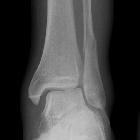ankle fractures
























Ankle fractures account for ~10% of fractures encountered in trauma, preceded only in incidence by proximal femoral fractures in the lower limb. They have a bimodal presentation, involving young males and older females. Ankle injuries play a major part in post multitrauma functional impairment thereby necessitating a detailed evaluation.
Classification
The first classification system was proposed by Percival Pott , describing fractures in terms of malleoli involved: unimalleolar, bimalleolar and trimalleolar. Despite its ease to identify fractures and decreased inter/intra observer variability, it has been superseded by two systems of classification which takes into consideration the rotational mechanism of injury and the stability of the fracture; each has its own advantages and disadvantages:
Radiographic features
An approach to reading ankle radiograph can be read here.
Treatment and prognosis
Results following the anatomic reduction of a displaced ankle fracture are good. Post-traumatic arthritis has been reported in ~15% of patients despite an anatomic reduction, likely due to chondral injury .
Siehe auch:
- Weber-B-Fraktur
- Weber-C-Fraktur
- Weber-A-Fraktur
- Ligamentum collaterale mediale
- Pilon tibiale Fraktur
- Ottawa ankle rules
- distale Fibulafrakturen
- trimalleoläre Sprunggelenksfraktur
- bimalleoläre Sprunggelenksfraktur
- Lauge-Hansen classification
- kindliche Sprunggelenksfrakturen
und weiter:

 Assoziationen und Differentialdiagnosen zu Danis-Weber classification:
Assoziationen und Differentialdiagnosen zu Danis-Weber classification:





